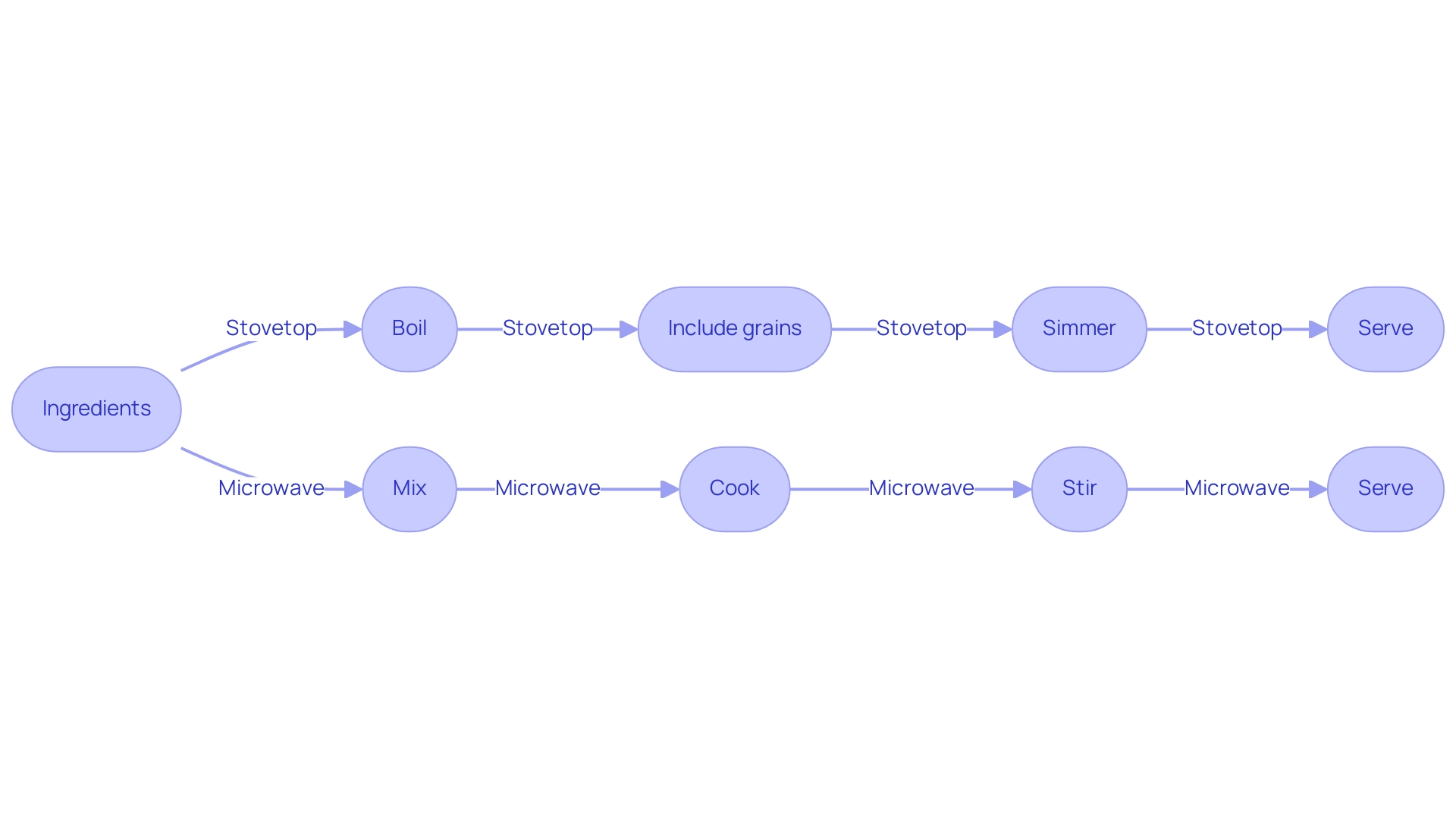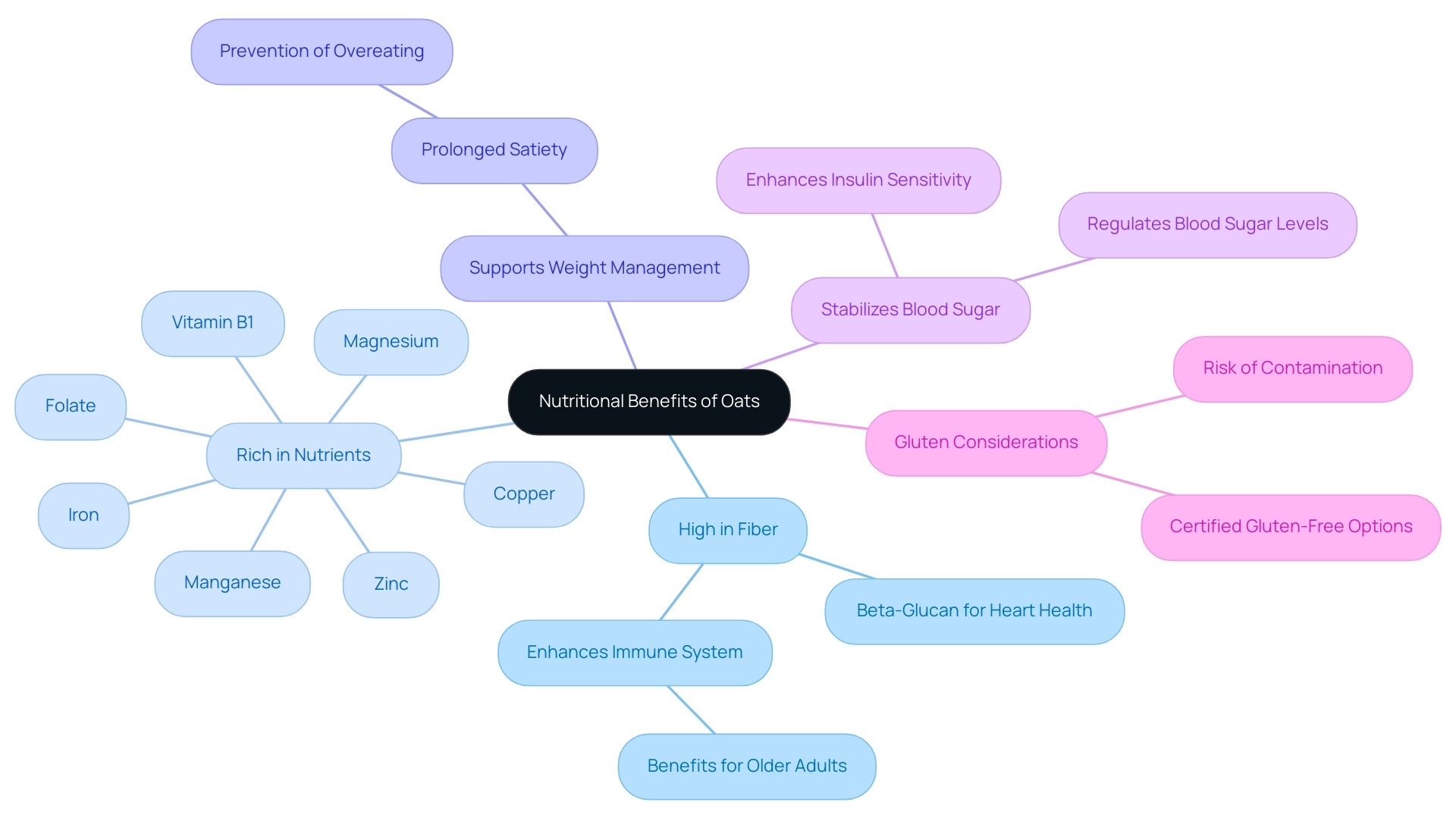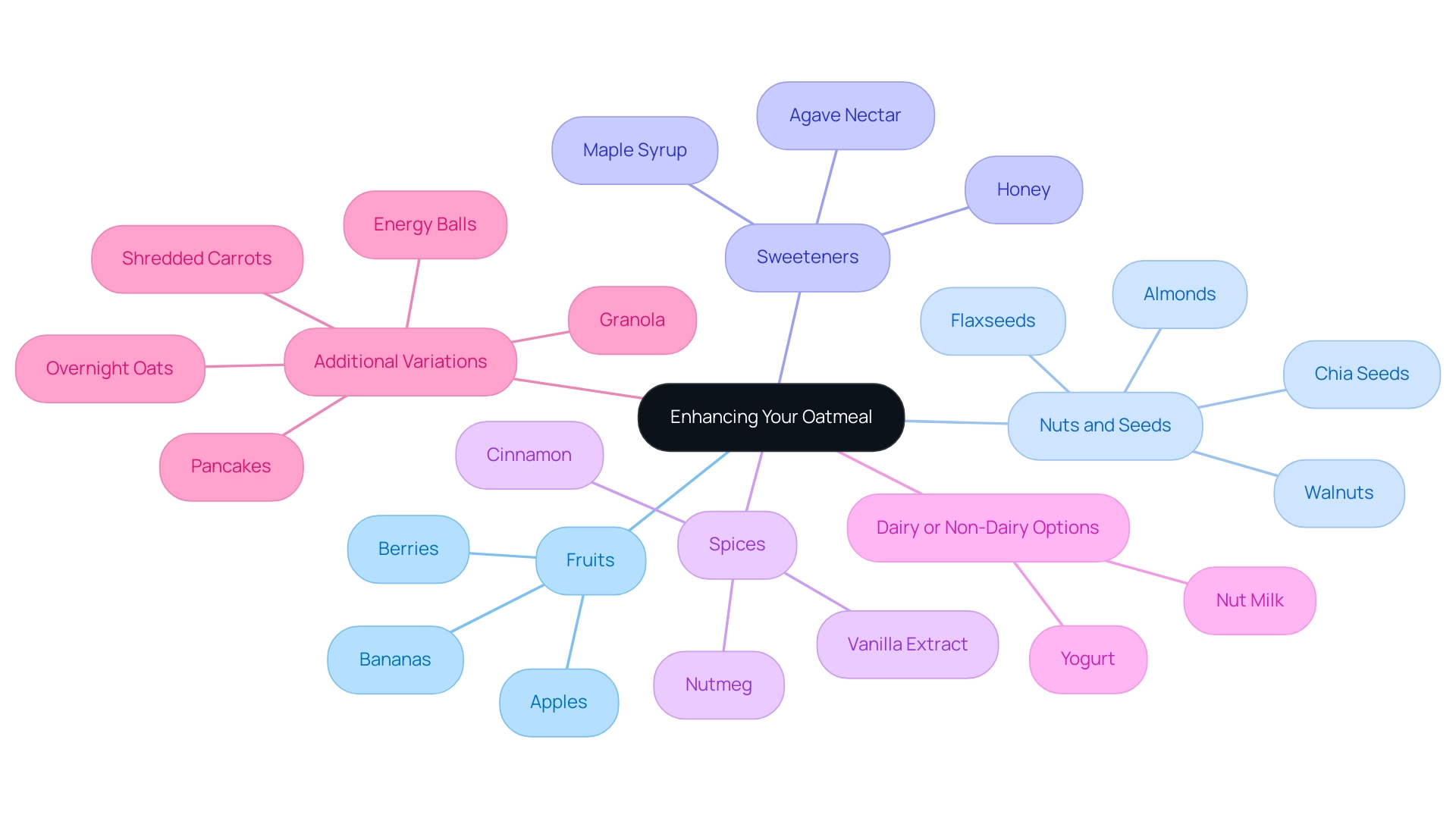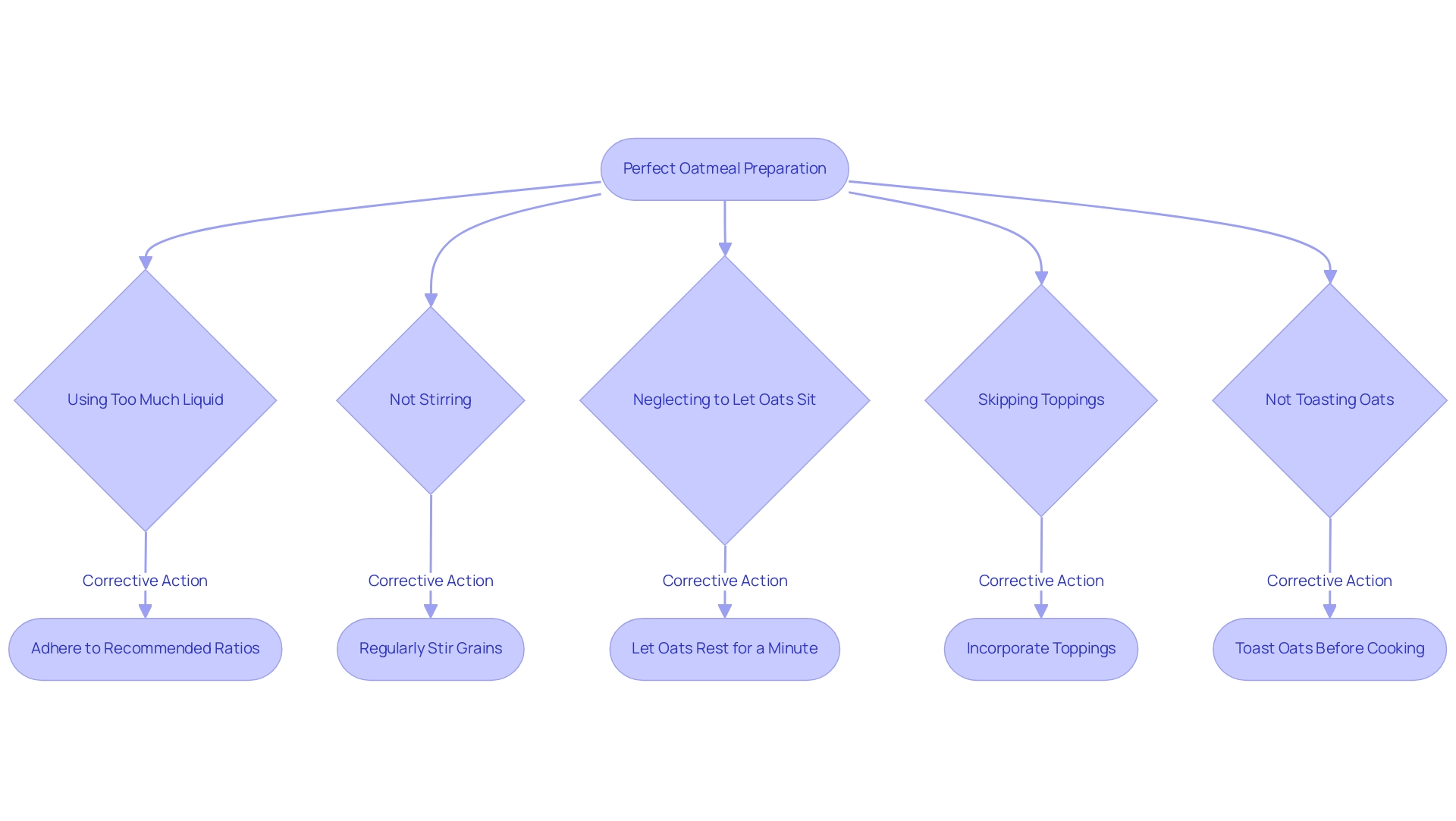Introduction
Oats have emerged as a staple in many diets due to their versatility and impressive nutritional profile. With various types available, including whole, rolled, and steel-cut oats, each offers distinct textures, flavors, and health benefits that cater to different culinary preferences.
This article delves into the unique characteristics of each oat variety, providing insights into how they can be effectively prepared and incorporated into meals. Additionally, it explores the numerous nutritional benefits of oats, including their role in:
- Heart health
- Weight management
- Blood sugar stabilization
For those looking to enhance their oatmeal experience, a range of toppings and flavor variations will be discussed, along with common pitfalls to avoid when preparing this wholesome breakfast option.
Whether one is a health-conscious eater or simply looking to diversify their meals, understanding the different types of oats and how to best utilize them can lead to a more satisfying and nutritious diet.
1. Exploring Different Types of Oats: Whole, Rolled, and Steel-Cut
Oats come in several varieties, each providing unique textures, flavors, and health benefits.
Whole Grains: As the least processed form of grains, whole grains retain all components—the bran, germ, and endosperm. Although they require a longer cooking time, they provide the highest nutritional value, packed with both soluble and insoluble fiber, particularly beta-glucan, which contributes to cholesterol reduction and overall heart health.
Rolled Grains: Often referred to as old-fashioned grains, rolled grains undergo steaming before being flattened. This method enables them to prepare more rapidly than whole grains while still maintaining a chewy consistency. A notable advantage is their versatility in recipes, making them a popular choice among health enthusiasts.
Moreover, a 1/2 cup serving of rolled grains contains only 1.0 gram of sugar, making them a favorable option for balanced nutrition.
Steel-Cut Grains: These grains consist of whole groats that are chopped into pieces, resulting in a hearty consistency and a nutty flavor. Recent studies have shown that steel-cut grains may help
curb hunger more effectively than other varieties due to their larger, unbroken pieces, which take longer to digest, thereby promoting satiety.
When considering the nutritional benefits, whole grains provide the most fiber, while rolled varieties offer a balance of quick preparation and nutritional value. Steel-cut grains, with their unique structure, not only promote satiety but also add a distinct texture to dishes. This nutritional comparison emphasizes the significance of choosing the suitable grain variety according to individual dietary requirements and preparation preferences.
A modern instance of integrating grains into popular recipes can be observed in TikTok’s viral mac and cheese, where nutritionists recommend incorporating rolled grains to improve creaminess and nutritional benefits without compromising taste. Choosing the appropriate variety of grains is vital for attaining the preferred texture and taste in your dishes. As culinary expert Aysegul Sanford states,
Here, we’re all about recipes that have been meticulously tested to provide you with a truly foolproof experience in the kitchen regardless of your level of expertise.
This emphasis on tested recipes further underlines the importance of choosing the appropriate oats type for optimal results.
2. Step-by-Step Guide to Cooking Oatmeal: Stovetop and Microwave Methods
Stovetop Method:
-
Ingredients: Start with 1 cup of grains and 2 cups of water or milk to achieve a creamy texture.
-
Boil: In a medium saucepan, bring the water or milk to a vigorous boil, ensuring a rapid start to the cooking process.
-
Include grains: Once boiling, stir in the grains and promptly reduce the heat to low to prevent burning.
-
Simmer: Allow the mixture to simmer for 5-10 minutes, stirring occasionally. This step is crucial as it helps the oats to absorb the liquid, which ultimately results in a smooth and creamy consistency.
-
Serve: After cooking, remove from heat and let it rest for a minute before serving. This resting period enhances the texture.
Microwave Method:
-
Ingredients: Use the same ratio of 1 cup of grains to 2 cups of water or milk, making it a convenient option for quick meals.
-
In a microwave-safe bowl, thoroughly mix the grains and liquid, ensuring even distribution.
-
Cook oats in the microwave on high for 2-3 minutes, keeping a close watch to prevent overflow—a common issue.
-
Stir: Pause halfway through the preparation time to stir the mixture. This not only helps prevent lumps but also promotes even cooking.
-
Serve: Allow the mixture to cool slightly before serving to enhance the flavor and avoid burns.
Both methods produce delicious porridge, providing flexibility based on your time constraints and available equipment. Recent trends indicate that microwave preparation is
gaining popularity, particularly among busy individuals, while the stovetop method remains favored for those seeking a more traditional approach. As Carol E. O'Neil from the School of Nutrition and Food Sciences notes, "the objective of this study was to assess the association between oats intake and nutrient consumption, diet quality, and weight/adiposity of children aged 2–18," highlighting the nutritional benefits of oats consumption.
Furthermore, a case study titled 'Impact of Breakfast Cereal Consumption on BMI' indicates that breakfast cereal consumption, including other types, is linked to lower BMI and reduced risk of overweight and obesity. Including oats in your diet can aid in weight management by increasing satiety, making it a strategic choice for health-conscious individuals. Additionally, statistics from the USDA's Food and Nutrient Database show a growing number of consumers of oats, reinforcing their popularity and nutritional benefits.
3. Nutritional Benefits of Oats: Why They Are a Healthy Choice
Oats are exceptionally nutritious and provide a multitude of health advantages, including being high in fiber, as they are particularly abundant in soluble fiber, especially beta-glucan, which plays a crucial role in lowering cholesterol levels and promoting heart health. This viscous fiber not only aids in cholesterol reduction but also
enhances the immune system, which is particularly beneficial for older adults. Furthermore, the viscous nature of beta-glucan in oats may prolong the sensation of satiety, assisting in weight management, as highlighted in studies on fiber-rich foods.
-
Rich in Nutrients: Oats are a powerhouse of essential vitamins and minerals, including manganese, phosphorus, magnesium, copper, iron, zinc, folate, and vitamin B1, all of which contribute to various bodily functions and overall health.
-
Supports Weight Management: The fiber-rich composition of oats fosters a prolonged feeling of fullness, thereby assisting in weight control.
Foods rich in fiber, such as porridge, can help prevent overeating and support weight loss efforts through increased satiety. One cup of prepared oats contains 153.5 calories, making it a nutritious option for those looking to manage their weight effectively.
-
Stabilizes Blood Sugar: Oats can enhance insulin sensitivity and aid in regulating blood sugar levels, making them a suitable option for individuals with diabetes. By promoting stable blood sugar levels, they contribute to better overall metabolic health.
It's important to note that while these grains are generally well tolerated, they may be contaminated with gluten, making it crucial for individuals with celiac disease to consume certified gluten-free alternatives. Including grains in your diet can result in considerable enhancements in overall health and well-being, as emphasized by various nutritionists and ongoing research in 2024. As Hrefna Palsdottir, MS, emphasizes, the health benefits of oats not only extend beyond basic nutrition but also enhance both heart health and weight management.
4. Enhancing Your Oatmeal: Toppings and Flavor Variations
To enhance the flavor and nutritional profile of your porridge, consider incorporating the following toppings and variations:
-
Fruits: Fresh fruits such as bananas, berries, or apples introduce natural sweetness along with essential vitamins and antioxidants. These fruits not only enhance flavor but also contribute to overall health.
-
Nuts and Seeds: Adding almonds, walnuts, chia seeds, or flaxseeds provides a rich source of healthy fats and protein, promoting satiety and nutritional balance.
-
Sweeteners: Natural sweeteners like honey, maple syrup, or agave nectar can enhance the sweetness of your dish without relying on refined sugars, making your meal healthier.
-
Spices: Incorporating spices such as cinnamon, nutmeg, or vanilla extract can significantly elevate the flavor profile, offering both taste and aromatic appeal.
-
Dairy or Non-Dairy Options: Creaminess can be added with yogurt or nut milk, both of which also contribute additional nutrients, making your dish more satisfying.
This meal is not only versatile but also ranks third overall and first among breakfast foods in terms of fullness effect, making it a top choice for a nutritious option. Experimenting with different combinations allows the grain to transform into a fulfilling dish. As Amanda Hershon, a Test Kitchen Specialist at Campbell Soup Company, noted,
Tastewise has been really instrumental in being able to have a greater impact across all the different projects.
This emphasizes the creativity in porridge preparation, which is increasingly important in 2024. For instance, shredded carrots can be added for a dessert-like breakfast, providing vitamins and minerals, particularly vitamin A for eye health. By embracing these various toppings and considering recipes like oats, granola, and energy balls, you can enjoy a nutritious and flavorful porridge experience tailored to your preferences.
5. Common Mistakes to Avoid for Perfect Oatmeal
To achieve the perfect bowl of oatmeal, it is crucial to avoid several common mistakes that can compromise both flavor and texture:
-
Using Too Much Liquid: Excessive liquid can lead to a soupy consistency. Adhering to the recommended ratios is essential for achieving the desired texture. As mentioned by culinary expert Sarah Nowicki Nicholson, "If you've got a little more time and have decided to prepare your grains on the stovetop, the ratio shifts from one-to-one to two-to-one."
-
Not Stirring: Neglecting to stir the grains while cooking can result in uneven cooking and clumping. Regular stirring is key to achieving a uniform texture. Overcooking oats for an extended period can lead to mushiness. It is important to monitor preparation times closely to maintain the ideal consistency.
-
Neglecting to Let Oats Sit: Allowing oats to rest for a minute after preparation can significantly enhance both consistency and flavor. This brief waiting period allows the grains to absorb any remaining liquid, resulting in a firmer consistency.
-
Skipping Toppings: Oats can be bland on their own; incorporating toppings not only elevates the taste of oats but also boosts their nutritional value. Simple additions of fruits, nuts, or spices can transform a basic bowl into a satisfying meal.
-
Not Toasting Oats: Toasting oats before cooking them enhances their flavor and texture, providing a nuttier taste and firmer consistency. You can toast oats at 350°F in the oven for 10-15 minutes or in a dry skillet over medium heat, stirring frequently.
Additionally, it’s important to keep the preparation of the cereal simple. As Miriam Hahn advises, adding too many ingredients can lead to decision fatigue. Sticking with a theme of complementary flavors and textures, such as using only dried fruits and nuts or savory ingredients like eggs and avocado, can help create a perfect bowl of porridge.
By steering clear of these prevalent pitfalls and incorporating these techniques, you can consistently prepare a delicious and satisfying bowl of oats.
Conclusion
Understanding the different types of oats—whole, rolled, and steel-cut—reveals their unique textures and health benefits, allowing individuals to tailor their choices to suit personal dietary needs. Whole oats provide the highest nutritional value, while rolled oats offer versatility, and steel-cut oats excel in promoting satiety. Each variety plays a significant role in heart health, weight management, and blood sugar stabilization.
The methods for preparing oatmeal, whether on the stovetop or in the microwave, showcase the convenience and adaptability of this nutritious food. With proper cooking techniques and an understanding of common mistakes to avoid, achieving the perfect bowl of oatmeal becomes an attainable goal for anyone.
Furthermore, enhancing oatmeal with a variety of toppings can elevate its taste and nutritional profile, making it not only a wholesome meal but also a satisfying one. By incorporating fruits, nuts, spices, and other nutritious ingredients, oatmeal can be transformed into a flavorful dish that meets diverse culinary preferences.
Incorporating oats into daily meals can lead to significant health benefits, reaffirming their status as a staple in a balanced diet. By making informed choices about oat varieties and preparation methods, individuals can enjoy the numerous advantages that oats offer, ultimately contributing to a healthier lifestyle.

































